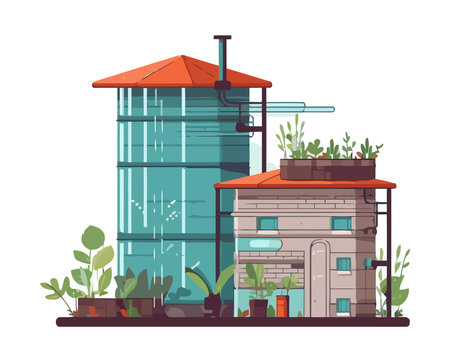Understanding Xeriscaping and Its Benefits
Xeriscaping is a landscaping method designed to reduce or eliminate the need for supplemental water from irrigation. Originally developed for dry, arid climates, xeriscaping has become a popular and sustainable choice across many parts of the United States, especially in areas that are prone to drought or where water conservation is a priority.
What Is Xeriscaping?
At its core, xeriscaping focuses on using native and drought-tolerant plants, efficient irrigation practices, soil improvement, and thoughtful design to create beautiful yet low-maintenance outdoor spaces. Unlike traditional landscaping that often relies on water-intensive lawns and exotic plants, xeriscaped yards are tailored to thrive with minimal watering.
Key Features of Xeriscaping
| Feature | Description |
|---|---|
| Drought-Tolerant Plants | Plants adapted to your local climate, requiring less water and care. |
| Efficient Irrigation | Drip systems and smart timers reduce water waste. |
| Mulching | Helps retain soil moisture and prevent weeds. |
| Soil Improvement | Enhancing soil with compost or organic matter improves water retention. |
| Thoughtful Design | Zones are created based on plant water needs, maximizing efficiency. |
Why Consider Xeriscaping?
If you live in an area with limited rainfall, frequent drought conditions, or high water costs, xeriscaping can be an ideal solution. Not only does it help conserve water, but it also reduces maintenance needs and lowers your utility bills over time. Plus, many homeowners appreciate the unique and natural look of xeriscaped yards.
Benefits at a Glance
| Benefit | How It Helps |
|---|---|
| Water Conservation | Lowers outdoor water use by up to 60% compared to traditional lawns. |
| Lower Maintenance | No mowing or frequent watering required. |
| Saves Money | Reduced utility bills and fewer landscaping supplies needed. |
| Environmental Impact | Cuts down on fertilizer and pesticide use, promoting local ecosystems. |
The Value of Hiring a Professional
While it’s possible to DIY a xeriscape yard, hiring a professional can save you time and ensure better results. A knowledgeable xeriscape landscaper understands local plant species, soil types, zoning requirements, and irrigation systems. They can help you design a landscape that not only looks great but also performs well year-round with minimal upkeep.
When Might You Need a Pro?
- You’re unfamiliar with native or drought-tolerant plants in your region.
- Your current yard has poor drainage or problematic soil conditions.
- You want a custom design that complements your home’s architecture.
- You’re looking for long-term cost savings through efficient installation.
Xeriscaping is more than just removing grass—it’s about creating smart landscapes that work with nature instead of against it. Understanding its core principles and benefits is the first step toward making an informed decision when hiring a professional for the job.
2. Where to Find a Xeriscape Professional
Finding the right xeriscape professional doesn’t have to be overwhelming. There are several reliable sources you can explore, both online and in your local community. Here’s a breakdown of the best places to start your search.
Ask for Recommendations
One of the easiest ways to find a trusted xeriscaping expert is by asking people you know. Neighbors, friends, or local community groups who have already gone through the process can offer valuable insights and referrals. They might even show you their yard and share what worked—and what didn’t—with their contractor.
Use Online Directories and Review Sites
Online platforms make it easy to compare professionals based on reviews, services, and pricing. Here are some popular websites where you can search for qualified xeriscaping contractors:
| Platform | Description | Key Features |
|---|---|---|
| Houzz | A home design and remodeling platform with a directory of landscaping pros. | User reviews, project photos, location filters |
| Angi (formerly Angie’s List) | A home services site that connects homeowners with vetted professionals. | Verified reviews, service guarantees, cost estimates |
| Yelp | A crowd-sourced review platform where users rate local businesses. | User photos, detailed feedback, star ratings |
| HomeAdvisor | A site that matches homeowners with licensed contractors in their area. | Background-checked pros, cost guides, scheduling tools |
Check Local Eco-Friendly Landscaping Associations
Xeriscaping is closely tied to sustainable landscaping practices. Many regions have associations or nonprofit organizations focused on water-wise gardening and eco-friendly landscaping. These groups often maintain directories of certified or recommended contractors. Try searching for:
- Your state’s native plant society or water conservation group
- Local chapters of the American Society of Landscape Architects (ASLA)
- Municipal water agencies offering xeriscape programs or rebates
Visit Garden Centers and Nurseries
Your nearby garden center or nursery might be connected with landscape designers who specialize in drought-tolerant plants. Staff members often know which professionals regularly buy native species or have experience creating low-water landscapes.
Tip:
When visiting these places, bring photos of your yard and ask if they can recommend someone who understands your regions climate and soil conditions.
Attend Local Home and Garden Shows
Home expos and garden shows are great opportunities to meet multiple contractors in one place. You can ask questions face-to-face, see examples of their work, and get a feel for their approach before committing to a consultation.
With so many resources available—from neighbors to online platforms—you’re sure to find a xeriscape professional who fits your needs and style.

3. Credentials and Experience to Look For
When hiring a xeriscape professional, it’s important to make sure they have the right credentials and experience to do the job well. Not all landscapers specialize in xeriscaping, so you’ll want to find someone who truly understands water-efficient landscaping and native plants.
Licenses and Certifications
A qualified xeriscaping professional should hold appropriate licenses required by your state or local government. In many areas, landscapers must be licensed contractors. Additionally, look for certifications that show their commitment to sustainable landscaping practices.
Common Licenses and Certifications
| Credential | Description | Why It Matters |
|---|---|---|
| Landscape Contractor License | Issued by the state; allows them to legally perform landscaping work | Ensures they meet legal and safety standards |
| Certified Xeriscape Professional (CXP) | Offered by some regional water conservation agencies or landscaping associations | Shows expertise in low-water-use landscape design |
| ISA Certified Arborist | Certification from the International Society of Arboriculture | Useful if trees are part of your xeriscape plan |
| LEED Accreditation | Leadership in Energy and Environmental Design certification | Indicates knowledge of green building practices, including sustainable landscapes |
Experience with Xeriscaping Projects
Ask potential hires about their past projects. Experience matters—especially when it comes to understanding regional climates, native plants, irrigation systems, and soil conditions. A seasoned pro will know how to create a beautiful, low-maintenance yard that saves water without sacrificing style.
Questions to Ask About Experience
- How many xeriscaping projects have you completed?
- Can you provide before-and-after photos of your work?
- Do you have references from past clients with similar projects?
- What types of native or drought-tolerant plants do you recommend for this area?
- Have you worked with local water conservation programs or rebates?
How to Verify Their Background
Don’t just take their word for it. Verify licenses through your state contractor licensing board. Check certifications with the issuing organizations. Read online reviews on platforms like Yelp, Google, or Angie’s List. And always call references—they can give you honest feedback about their experience working with the professional.
Tip:
If a contractor hesitates to share credentials or examples of past work, that could be a red flag. A reputable xeriscaping pro will be proud to show off their qualifications and portfolio.
4. Important Questions to Ask During Consultations
Before hiring a xeriscape professional, its essential to sit down for a consultation and ask the right questions. This helps you better understand their experience, design approach, and whether they align with your sustainability goals and budget. Here are key questions to guide your conversation:
Experience and Credentials
- How long have you been working in xeriscaping?
- Do you have any certifications or formal training in sustainable landscaping?
- Can you provide references or examples of past xeriscape projects?
Design Approach
- How do you choose drought-tolerant plants suitable for my region?
- What is your process for creating a low-maintenance, water-efficient design?
- How do you incorporate native plants and soil conditions into your planning?
Sustainability Practices
- Do you use eco-friendly materials in your designs?
- How do you plan irrigation systems to minimize water use?
- Can you help me reduce or eliminate the need for chemical fertilizers and pesticides?
Project Management and Budget
- What is your estimated timeline for completing this project?
- Can you provide a detailed quote or estimate upfront?
- If the project goes over budget, how do you handle unexpected costs?
Quick Reference: Key Questions Checklist
| Category | Questions to Ask |
|---|---|
| Experience | How long have you worked in xeriscaping? Can I see past projects? |
| Design Vision | What is your approach to plant selection and water conservation? |
| Sustainability | Do you focus on eco-friendly practices and materials? |
| Budget & Timeline | Can you give an accurate quote and timeline? How do you manage changes? |
Taking the time to ask these questions will not only help you choose the right xeriscape professional but also ensure that your landscaping project aligns with both your aesthetic goals and environmental values.
5. Evaluating Quotes and Project Proposals
Once youve interviewed a few xeriscaping professionals, the next step is to evaluate their quotes and project proposals. This part of the process helps you compare what each expert is offering so you can make an informed decision that fits your budget, timeline, and design goals.
Compare Apples to Apples
Not all quotes are created equal. One contractor might include specific plants and drip irrigation systems, while another may use more generic descriptions or skip important details. Make sure youre comparing similar services across each proposal.
Key Elements to Review:
- Scope of Work: What exactly is included? Are they handling design, installation, and maintenance?
- Materials: What types of plants, mulch, rocks, or irrigation systems are being used?
- Timeline: When can they start and how long will the project take?
- Total Cost: Is the estimate all-inclusive or will there be additional charges?
- Warranties or Guarantees: Do they offer any protection for plants or workmanship?
Sample Comparison Table
| Contractor | Total Estimate | Project Duration | Main Materials | Warranty Offered |
|---|---|---|---|---|
| GreenScape Pros | $8,500 | 3 weeks | Drought-tolerant native plants, gravel mulch | 1-year plant guarantee |
| XeriLand Designs | $9,200 | 4 weeks | Cactus varieties, decomposed granite paths | No warranty listed |
| Sustainable Roots | $7,900 | 2.5 weeks | Low-water succulents, bark mulch | 6-month plant warranty + 90-day labor guarantee |
Ask About Flexibility and Customization
If one quote is slightly over your budget but includes everything you want, ask if theres room to adjust materials or scale down certain elements. A good professional will work with you to prioritize features without compromising quality.
Don’t Just Look at Price Alone
The lowest bid isn’t always the best choice. Consider experience, communication style, references, and how well they understand your vision. Sometimes paying a little more upfront can save you money in the long run by avoiding costly mistakes or rework.
Tip:
If youre unsure about anything in a proposal, don’t hesitate to ask for clarification. A reliable xeriscape professional will be happy to walk you through every detail.
This careful comparison will help ensure youre hiring someone who not only fits your budget but also aligns with your landscaping goals.
6. Finalizing the Contract and Setting Expectations
Once youve chosen a xeriscape professional, the next step is to finalize the contract and set clear expectations. A well-drafted contract protects both you and the contractor, ensuring everyone is on the same page before any work begins.
Key Elements of a Xeriscape Contract
A solid contract should clearly outline all aspects of the project. Heres a breakdown of what to include:
| Contract Element | Description |
|---|---|
| Scope of Work | Details about what tasks will be performed, including design, plant selection, soil preparation, irrigation changes, and installation. |
| Timeline | Start and completion dates, along with any milestones or phases of the project. |
| Payment Schedule | Total cost, deposit amount, and when payments are due (e.g., upfront, upon completion of stages). |
| Materials and Plants | List of agreed-upon plants, mulch types, and hardscaping materials. |
| Warranties | Covers what parts of the work or materials are guaranteed, for how long, and under what conditions. |
| Change Orders | A process for approving any changes in scope or costs during the project. |
| Cleanup Responsibilities | Defines who is responsible for debris removal and site tidiness during and after construction. |
Establishing Clear Communication Channels
Good communication is key to a successful xeriscape project. Before work begins, decide how often you’ll check in with your contractor and through which method—email, text, or phone calls. Knowing who your main point of contact is helps avoid confusion later on.
Tips for Effective Communication:
- Set Regular Updates: Weekly progress updates can help keep things on track.
- Create a Shared Calendar: Use Google Calendar or similar tools to track deadlines and meetings.
- Document Everything: Keep records of all communications and approvals in case any issues arise.
Aligning Expectations from Day One
Take time to talk through your vision with your contractor so they understand your goals. Are you aiming for low maintenance? Do you want native plants only? Clarify these details early on to prevent misunderstandings later.
Questions to Ask Before Signing the Contract:
- What happens if there’s a delay due to weather or materials?
- How do you handle unexpected costs?
- Can I review final plant selections before purchase?
- Who will be working onsite each day?
A detailed contract combined with clear communication ensures that your xeriscaping project goes smoothly—from concept to completion.


